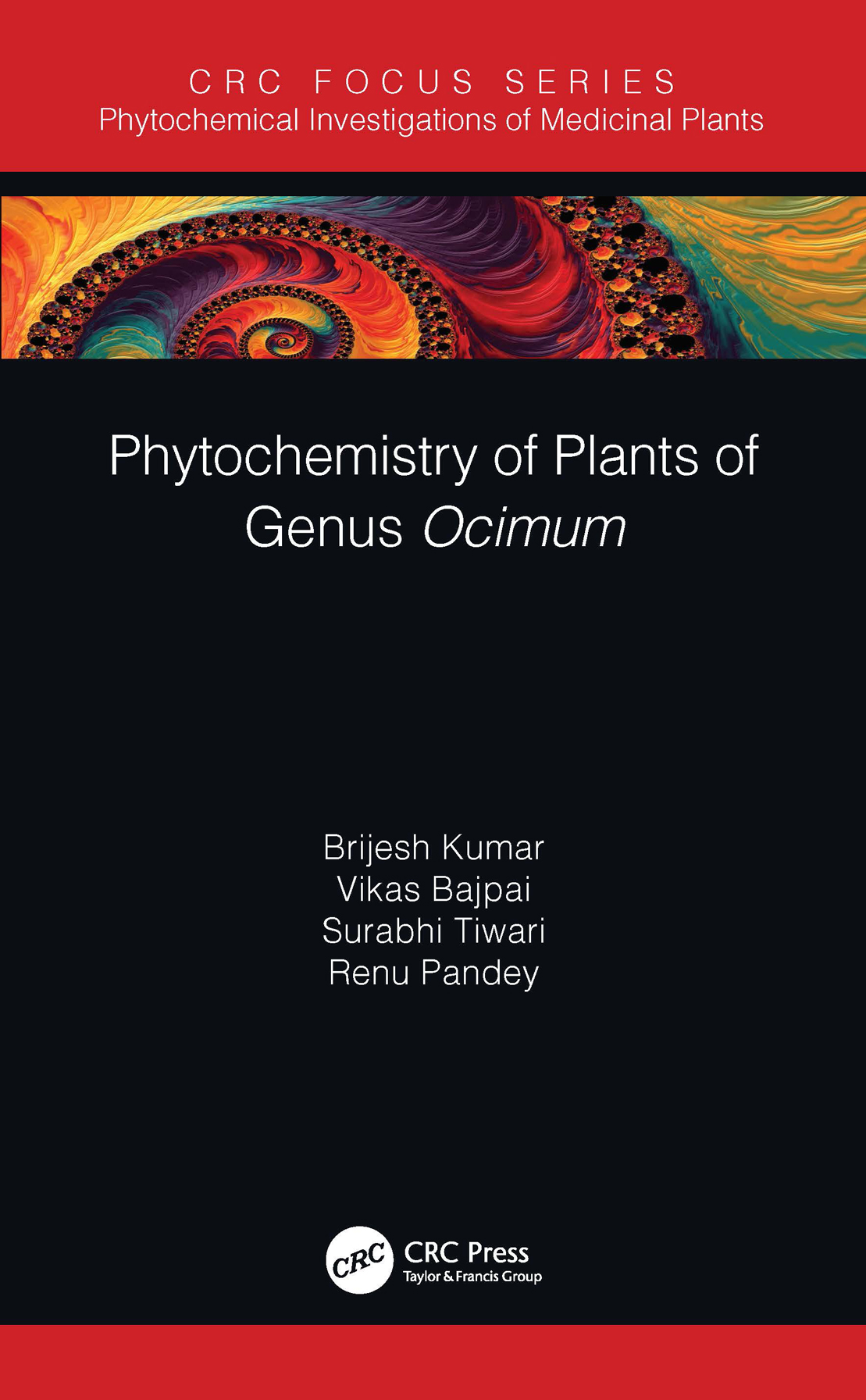Vikas Bajpai (editor) - Phytochemistry of plants of Genus Ocimum
Here you can read online Vikas Bajpai (editor) - Phytochemistry of plants of Genus Ocimum full text of the book (entire story) in english for free. Download pdf and epub, get meaning, cover and reviews about this ebook. year: 2020, genre: Romance novel. Description of the work, (preface) as well as reviews are available. Best literature library LitArk.com created for fans of good reading and offers a wide selection of genres:
Romance novel
Science fiction
Adventure
Detective
Science
History
Home and family
Prose
Art
Politics
Computer
Non-fiction
Religion
Business
Children
Humor
Choose a favorite category and find really read worthwhile books. Enjoy immersion in the world of imagination, feel the emotions of the characters or learn something new for yourself, make an fascinating discovery.

- Book:Phytochemistry of plants of Genus Ocimum
- Author:
- Genre:
- Year:2020
- Rating:3 / 5
- Favourites:Add to favourites
- Your mark:
- 60
- 1
- 2
- 3
- 4
- 5
Phytochemistry of plants of Genus Ocimum: summary, description and annotation
We offer to read an annotation, description, summary or preface (depends on what the author of the book "Phytochemistry of plants of Genus Ocimum" wrote himself). If you haven't found the necessary information about the book — write in the comments, we will try to find it.
Phytochemistry of plants of Genus Ocimum — read online for free the complete book (whole text) full work
Below is the text of the book, divided by pages. System saving the place of the last page read, allows you to conveniently read the book "Phytochemistry of plants of Genus Ocimum" online for free, without having to search again every time where you left off. Put a bookmark, and you can go to the page where you finished reading at any time.
Font size:
Interval:
Bookmark:

Series Editor:
Brijesh Kumar
Phytochemistry of Plants of Genus Phyllanthus
Brijesh Kumar, Sunil Kumar and K. P. Madhusudanan
Phytochemistry of Plants of Genus Ocimum
Brijesh Kumar, Vikas Bajpai, Surabhi Tiwari and Renu Pandey
Phytochemistry of Plants of Genus Piper
Brijesh Kumar, Surabhi Tiwari, Vikas Bajpai and Bikarma Singh
Phytochemistry of Tinospora cordifolia
Brijesh Kumar, Vikas Bajpai and Nikhil Kumar
Phytochemistry of Plants of Genus Rauvolfia
Brijesh Kumar, Sunil Kumar, Vikas Bajpai and K. P. Madhusudanan
Phytochemistry of Piper betle Landraces
Vikas Bajpai, Nikhil Kumar and Brijesh Kumar
For more information about this series, please visit: https://www.crcpress.com/Phytochemical-Investigations-of-Medicinal-Plants/book-series/PHYTO
First edition published 2020
by CRC Press
6000 Broken Sound Parkway NW, Suite 300, Boca Raton, FL 33487-2742
and by CRC Press
2 Park Square, Milton Park, Abingdon, Oxon, OX14 4RN
2020 Taylor & Francis Group, LLC
CRC Press is an imprint of Taylor & Francis Group, an Informa business
Reasonable efforts have been made to publish reliable data and information, but the author and publisher cannot assume responsibility for the validity of all materials or the consequences of their use. The authors and publishers have attempted to trace the copyright holders of all material reproduced in this publication and apologize to copyright holders if permission to publish in this form has not been obtained. If any copyright material has not been acknowledged please write and let us know so we may rectify in any future reprint.
Except as permitted under U.S. Copyright Law, no part of this book may be reprinted, reproduced, transmitted, or utilized in any form by any electronic, mechanical, or other means, now known or hereafter invented, including photocopying, microfilming, and recording, or in any information storage or retrieval system, without written permission from the publishers.
For permission to photocopy or use material electronically from this work, access
Trademark Notice: Product or corporate names may be trademarks or registered trademarks, and are used only for identification and explanation without intent to infringe.
ISBN: 978-0-367-85753-0 (hbk)
ISBN: 978-1-003-01485-0 (ebk)
Typeset in Times
by codeMantra
Plants are considered as one of the most important sources of drugs used to alleviate and treat different ailments since the beginning of human civilization. Medicinal plants and their bioactive secondary metabolites have been considered as a fundamental source of medicine for the treatment of a range of diseases in our modern medical system. India has a rich heritage of medicinal plants, used in Ayurveda, Siddha, Unani, Homoeopathy and Naturopathy since the ancient era. In India, about 60007000 plant species are utilized in traditional, folk and herbal medicines. The Ocimum is one of the most recognized and used genera that includes more than 150 species of herbs and shrubs with immense medicinal properties. It is distributed throughout the tropical regions of Asia, Africa, and Central and South America. Ocimum sanctum (Tulasi or Holy Basil) is found throughout tropical and semitropical regions of India and other Asian countries. Different parts of this plant are traditionally utilized in the Indian system of medicine for the treatment of ailments.
Herbal medicines/formulations involve the use of crude or processed plant parts containing one or several active constituents. Due to the rapid commercialization of the herbal medicines, accurate knowledge of their phytochemical composition, which is directly related to medicinal properties, is a very crucial aspect for the safety and efficacy of the products. According to the European Medicines Evaluation Agency (EMEA) and Food and Drug Administration (FDA) regulations, identification and determination of the active constituents are prerequisites for the development of modern evidence-based phytomedicines. Nevertheless, the use of medicinal herbs or herbal drugs is increasing throughout the world. One of the major issues of its acceptance is the lack of quality control or standardization. Standardization is an essential step for the establishment of consistent pharmacological activity, a reliable chemical profile or simply a quality control program for the production of herbal drugs. Standardization of medicinal herbs or herbal products is necessary for assessment of their safety, efficacy and quality. Recently, mass spectrometry has earned a central role in the field of plant metabolomics due to its sensitivity, selectivity and accuracy. It facilitates efficient analysis of metabolites in the complex matrix of plant extracts due to high sensitivity, selectivity and versatility. Liquid chromatography (LC) coupled with tandem mass spectrometry (MS/MS) detection has increased separation of compounds, which makes this technique more sensitive, selective and suitable for qualitative and quantitative analyses of plant metabolites.
The work contained in this book includes reports of phytochemical investigations and study of biological potential of Ocimum spp. Metabolic profiling of six Ocimum species, namely, O. americanum, O. basilicum, O. gratissimum, O. kilimandscharicum, O. sanctum green and O. sanctum purple using HPLC-QTOF-MS/MS was successfully completed. Bioactive phenolic acids, flavonoids, propenyl phenol and terpenoids were simultaneously quantified in leaf extracts of O. sanctum from different geographical regions and its marketed herbal formulations using UHPLC-QqQLIT-MS/MS. Similarly, fifteen bioactive phytoconstituents were determined in leaf extracts of six Ocimum species. We hope this book may be useful to academicians, researchers, manufacturers and users of herbal products according to their aims and objective. It is expected that the effort will open new vistas of knowledge for multidisciplinary research in the coming years.
31/12/2019 | The Authors |
The completion of this book is due to the Almighty who blessed us with all the resources required to accomplish this journey. We are glad to have the opportunity to express our gratitude to Dr. K. P. Madhusudanan, whose constant encouragement, guidance and support helped us to complete the task successfully. We express our deep sense of gratitude to Director of CSIR-Central Drug Research Institute (CDRI), Lucknow, India, for his support and Sophisticated Analytical Instrument Facility (SAIF) Division of CSIR-CDRI, where all the data were generated.

Dr. Brijesh Kumar is a Professor (Academy of Scientific and Innovative Research, AcSIR) and Chief Scientist of Sophisticated Analytical Instrument facility Division of CSIR-Central Drug Research Institute (CDRI), Lucknow, India. Currently, he is facility in charge of SAIF Division. He has completed his PhD from CSIR-CDRI, Lucknow, India (Dr. Ram Manohar Lohia Avadh University Faizabad, India). He has to his credit 7 book chapters, 1 book and 145 papers in International Journal of Repute. His current area of research is application of mass spectrometry (DART-MS/Q-TOF LC-MS/4000 Q Trap LC-MS/Orbitrap MSn) for qualitative and quantitative analyses of molecules for quality control and authentication/standardization of Indian medicinal plants/parts and their herbal formulations. He is also involved in identification of marker compounds using statistical software to check adulteration/substitution.
Font size:
Interval:
Bookmark:
Similar books «Phytochemistry of plants of Genus Ocimum»
Look at similar books to Phytochemistry of plants of Genus Ocimum. We have selected literature similar in name and meaning in the hope of providing readers with more options to find new, interesting, not yet read works.
Discussion, reviews of the book Phytochemistry of plants of Genus Ocimum and just readers' own opinions. Leave your comments, write what you think about the work, its meaning or the main characters. Specify what exactly you liked and what you didn't like, and why you think so.










